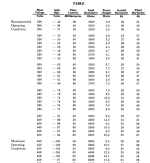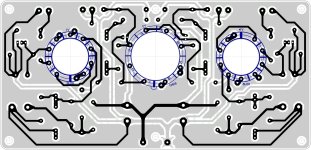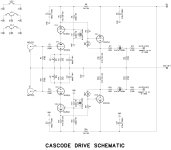I think the other posts have covered this. Speakers were Mission 761, 6 ohms nominal. I never got the 300b to sound as good as a 2a3 so ditched it a few years ago. In fact I use EL12n outputs most of the time so I can use a 26 input tube and thus get a 2 stage amp with a DHT driver. Much better driver stage than using miscellaneous 9 pin tubes so the final sound is much more to my taste.Hi Andy, et al, Just catching up on this...sorry, sometimes I am slow. 🙂
With (Z1/Z2) = 5k/5 = (n1/n2)^2 = 1000, if Z2 = 8, then Z1 = 8K! So much for your 5K transformer, and perhaps you have gone further than Sakuma sanin exploring alternatives...what is/was your loudspeaker Z when you did that?
Best, Robert
Truth!Some design, some build, some listen. And, I am sure some do not do any of those three.
300b has an rp of aobut 800 ohms, that is why 2.5k is used more often as power is good,
i learned a lot here from tube gurus like PRR et al....Hasn't anybody learned anything from all these threads in Tubes/Valves?
the truth is, while the circuit is constant, but parts and implantations, i.e construction vary so i do not expect the same results each time, there will be variations...Truth!
Right ... but if you use -for example- 5K load, the estimated (max) power decreasing only 3.5dB, but distortion will halved.... that is why 2.5k is used more often as power is good,
+1i learned a lot here from tube gurus like PRR et al....
I learned 100x more here than in all the books I have at home.
Here it's alive, even too lively sometimes, but it's constantly evolving while the books are frozen in their time.
damping factor increase tooRight ... but if you use -for example- 5K load, the estimated (max) power decreasing only 3.5dB, but distortion will halved.
Oh absolutely. And those tube curve charts are a guideline, not something written in stone. I get a circuit close and then fine tune it with some experimentation and listening to it.the truth is, while the circuit is constant, but parts and implantations, i.e construction vary so i do not expect the same results each time, there will be variations...
even parasitic and strays which are difficult to calculate have an effect also so that we have to assume and factor that in.......Oh absolutely. And those tube curve charts are a guideline, not something written in stone. I get a circuit close and then fine tune it with some experimentation and listening to it.
i remember a thread here chasing distortion figures in a honey badger amp, only to find out that his dummy loads contributed to distortions too.......nice discovery yes?
i remember PRR said many many years ago, not the exact quote but this stuck in my head "when you design a tube for 5ma plate current, be ready to find that in the actual circuit, it could very well be between 3 to 8mA...."
tube differences between tubes of the same types, of different manufacturer and even inside of the same envelope is real...
tube differences between tubes of the same types, of different manufacturer and even inside of the same envelope is real...
Last edited:
yes, that is the general idea and is well understood, those chasing power may not understand, i stopped counting watts years ago, we need watts to dimension parts and components but when all is said and done, a different ballgame...Right ... but if you use -for example- 5K load, the estimated (max) power decreasing only 3.5dB, but distortion will halved.
Last edited:
btw, @stephe i used your 6sn7 cascode to drive the 300b, but the owner finds the gain of the 6sn7 not to his liking, so i designed a 7dj8 cascode buffered by the Russian 6H8 and gains are a lot more...
Attachments
The other thing people ignore is the speaker and the impedance curve it has. The OT impedance is based off the load and many times, the speaker is not exactly 8ohms. It's overly simplistic and ignoring the whole system to look at the OT Z in isolation. And yeah, that 6SN7 cascode doesn't have a ton of gain, it really like a pre-amp or at least a fairly hot source. Your solution looks interesting!yes, that is the general idea and is well understood, those chasing power may not understand, i stopped counting watts years ago, we need watts to dimension parts and components but when all is said and done, a different ballgame...
sumotan,
I would appreciate a link to, or a schematic of a Shunt Cascode (I am not sure what that is).
Thanks!
A common cathode stage's plate that is DC connected to a grounded grid stage's cathode, is a traditional cascode, like that in a TV tuner front end.
Is a shunt cascode when there is no DC connection from the bottom triode's plate to the top triode's cathode?
But instead, when the bottom plate is capacitor coupled to the top cathode?
That is how a 10GHz Air Search Radar's 30MHz IF input amplifier stage did it (A very good noise figure at 30MHz).
P.S. I enjoyed my trip to Jakarta and to Surabaya.
I would appreciate a link to, or a schematic of a Shunt Cascode (I am not sure what that is).
Thanks!
A common cathode stage's plate that is DC connected to a grounded grid stage's cathode, is a traditional cascode, like that in a TV tuner front end.
Is a shunt cascode when there is no DC connection from the bottom triode's plate to the top triode's cathode?
But instead, when the bottom plate is capacitor coupled to the top cathode?
That is how a 10GHz Air Search Radar's 30MHz IF input amplifier stage did it (A very good noise figure at 30MHz).
P.S. I enjoyed my trip to Jakarta and to Surabaya.
Last edited:
Also, Ale Moglia has a good discussion of the shunt cascode at
https://www.bartola.co.uk/valves/2013/03/10/the-shunt-cascode-driver/
https://www.bartola.co.uk/valves/2013/03/10/the-shunt-cascode-driver/
- Home
- Amplifiers
- Tubes / Valves
- 300b with single stage driver, C3M or?


